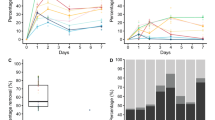Abstract
The ability of native wild isolate Penicillium cyclopium Westling to degrade commercial detergent Merix (Henkel, Serbia) as well as the influence of detergent on activities of some fungal enzymes was in the focus of this study. The fungus was isolated from the riverbed of Western Morava (Čačak, Serbia), at a place where municipal wastewater discharged into the river. The fungus was grown in Czapek-Dox liquid nutrient medium without and with addition of 0.3% detergent. The physico-chemical and biochemical changes of pH, redox potential, total biomass dry weight, activities of alkaline (AlkI) and acid (AcI) invertases and alkaline protease were evaluated from 3-rd to 16-th day of fungal growth. Also, detergent disappearance in terms of methylene blue active substances in the medium was measured. The detergent caused an inhibitory effect on fungal growth and biomass dry weight (about 33.4%). In spite of that, the fungus degraded about 47.0% of anionic surfactant of detergent after 16 days of incubation. The detergent stimulated AcI activity of P. cyclopium but inhibited AlkI and protease activities. Alkaline protease of the fungus retained high percentage of activity (87.7%) in presence of tested detergent. The obtained results indicate the potential of fungus in removing of surfactants and biotechnology.
Similar content being viewed by others
References
Harikumar, P., Jesitha, K., and Sreechithra, M., J. Environ. Prot., 2013, vol. 4, no. 5, pp. 418–425.
Cowan-Ellsberry, C., Belanger, S., Dorn, P., Dyer, S., McAvoy, D., Sanderson, H., et al., K., Crit. Rev. Environ. Sci. Technol., 2014, vol. 44, no. 17, pp. 1893–1993.
Linear Alkylate Sulfonates, Modler, R.F., Blagoev, M., and Inoguchi, Y., Eds., CA: Menlo Park, 2009.
Pettersson, A., Adamsson, M. and Dave, G., Chemosphere, 2000, vol. 41, no. 10, pp. 1611–1620.
European Commission. European Parliament Regulation (EC) No 648/2004 of the European Parliament and of Council of 31 March 2004 on Detergents, Official Journal of the European Union L 104, 2004, pp. 1–35.
Nikhil, T., Deepa, V., Rohan, G., and Satish, B., Int. Res. J. Environ. Sci., 2013, vol. 2, no. 2, pp. 48–52.
Sing, H., Mycoremediation, New Jersey: John Wiley and Sons, Inc., 2006.
Garon, D., Sage, L., and Seigle-Murandi, F., Biodegradation, 2004, vol. 15, no. 1, pp. 1–8.
Boonchan, S., Britz, M.L., and G.A. Stanley, Appl. Environ. Microbiol., 2000, vol. 66, no. 3, pp. 1007–1019.
Saraswathy, A. and Hallberg, R., FEMS Microbiol. Lett., 2002, vol. 210, no. 2, pp. 227–232.
Saraswathy, A. and Hallberg, R., Microbiol. Res., 2005, vol. 160, no. 4, pp. 375–383.
Bioremediation of Contaminated Soil, Wise, D.L., Debra, J.T., Cichon, E.J., Inyang, H.I., and Stottmeister, U. Eds., New York: Marcel Dekker, 2000.
Meléndez-Estrada, J., Amezcua-Allieri, M.A., Alvarez, P.J.J., and Rodríguez-Vázquez, R., Environ. Technol., 2006, vol. 27, no. 10, pp. 1073–1080.
Sack, U. and Gunther, T., J. Basic Microbiol., 1993, vol. 33, no. 4, pp. 269–277.
Jakovljević, V., Milićević, J., and Stojanović, J., Biotechnol. Biotec. Eq., 2014, vol. 28, no. 1, pp. 43–51.
Leitão, A.L., Int. J. Environ. Res. Public Health, 2009, vol. 6, no. 4, pp. 1393–1417.
Tan, H., Deng, Z., and Cao, L., Lett. Appl. Microbiol., 2009, vol. 49, no. 2, pp. 248–253.
Sonjak, S., Frisvad, J.C., and Gunde-Cimerman, N., FEMS Microbiol. Ecol., 2005, vol. 53, no. 1, pp. 51–60.
Chatterjee, S., J. Adv. Pharm. Technol. Res., 2015, vol. 6, no. 1, pp. 2–6.
Esawy, M.A., Kansoh, A.L., Kheiralla, Z.H., Ahmed, H.A.E., Kahil, T.A.K. and El-Hameed, E.K.A., Int. J. Biotechnol. Wellness Ind., 2014, vol. 3, no. 2, pp. 36–45.
Standard Methods for the Examination of Water and Wastewater, Eaton, A.D., Clesceri, L.S., Rice, E.W. and Greenberg, A.E., Eds., Washington: American Water Works Association; Water Pollution Control Federation, 2005.
Somogyi, M., J. Biol. Chem., 1952, vol. 195, pp. 19–23.
Anson, M.L., J. Gen. Physiol., 1938, vol. 20, pp. 79–89.
Nascimento, A.W.C. and Martins, L.M.L., Braz. J. Microbiol., 2006, vol. 37, no. 3, pp. 307–311.
Stojanović, J., Milićević, J., Gajović, O., Jakovljević, V., Matović, I., Mijušković, Z., and Nedeljković, T., Arch. Biol. Sci., 2011, vol. 63, no. 4, pp. 1001–1006.
Jakovljević, V.D., Stojanović, J.D., and Vrvić, M.M., Chem. Ind. Chem. Eng. Q., 2015, vol. 21, no. 1, pp. 131–139.
Jakovljević, V.D., Milićević, J.M., Stojanović, J.D., and Vrvić, M.M., Chem. Ind. Chem. Eng. Q., 2014, vol. 20, no. 4, pp. 587–595.
Velan, M., Sheeba Varma, S., Gnanambigai, P. and Lakshmi, M.B., IJCEE, 2012, vol. 3, no.5, pp. 318–323.
Pessoni, R., Braga, A.B.M.R., and Figueiredo-Ribeiro, R.C.L., Mycologia, 2007, vol. 99, vol. 4, pp. 493–503.
Santana de Almeida, A.C., de Araujo, L.C., Costa, A.M., Morales de Abreu, C.A., Gomes de Andrade Lima, M.A., and Perez Fernandez Palha, M.L.A., Electron. J. Biotechn., 2005, vol. 8, no. 1, pp. 54–62.
Shankar, T., Thangamathi, P., Rama, R., and Sivakumar, T., Afr. J. Microbiol. Res., 2014, vol. 8, no. 13, pp. 1385–1393.
Nehra, K.S., Dhillon, S., Chaudhary, K., and Singh, R., Ind. J. Microbiol., 2002, vol. 42, no. 1, pp. 43–47.
Kumar, A., Sachdev, A., Balasubramanyam, S.D., Saxena, A., and Lata, K., Ind. J. Microbiol., 2002, vol. 42, no. 3, pp. 233–236.
Subba Rao, Ch., Sathish, T., Ravichandra, P., and Prakasham, R.S., Process Biochem., 2009, vol. 44, no. 3, pp. 262–268.
Rani, M.R., Prasad, N.N., and Sambasivarao, K.R.S., Asian J. Exp. Biol. Sci., 2012, vol. 3, no. 3, pp. 565–575.
Author information
Authors and Affiliations
Corresponding author
Additional information
The article is published in the original.
Rights and permissions
About this article
Cite this article
Jakovljević, V.D., Vrvić, M.M. Potential of Penicillium cyclopium westling for removing of anionic surfactants and biotechnology. Appl Biochem Microbiol 51, 704–711 (2015). https://doi.org/10.1134/S000368381506006X
Received:
Published:
Issue Date:
DOI: https://doi.org/10.1134/S000368381506006X




